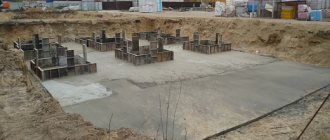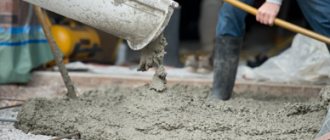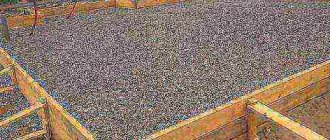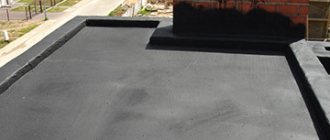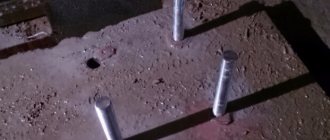Modern technologies make it possible to resort to a choice of various options for installing a pillow under the foundation. Let's consider the criteria on which the choice of a particular material is based, as well as the scope of application of each type of substrate, the rules for their design and the general technology for preparing a construction site. After reading the article, it will be clear what exactly you need to ask sellers and craftsmen when ordering a foundation.
Sand-gravel mixture Source stpulscen.ru
Functional meaning
Any structure exerts some kind of load on the ground. So that it does not sag and the load is distributed evenly, a mineral foundation cushion is placed over the entire supporting area. In addition, the following issues are resolved:
- the construction site is leveled;
- compensates for soil movement during seasonal changes;
- a protective barrier is installed against the direct impact of soil on the foundation;
- the level of soil stability increases, which is especially important for seismically unstable regions;
- a drainage system is provided to remove melt and rainwater from the building.
This or that execution is determined by the state of the working site. This is the type of soil, indicators regarding groundwater, and climatic conditions of the area. The material and design features of the structure being built are also taken into account. The base can consist of sand, gravel and crushed stone, with a dry concrete screed. Before casting the foundation, the cushion is compacted while maintaining a horizontal level.
Tamping machine Source static.tildacdn.com
The use of geotextiles in the construction of foundations
The use of geotextile fabrics allows for:
- separation of individual bulk layers, eliminating their siltation over time;
- waterproofing the foundation with geotextiles;
- uniform distribution of weight loads from building structures on the ground;
- improved drainage properties of the lower crushed stone layer and, as a result, free removal of moisture;
- additional reinforcement and general strengthening of structures.
For strengthening, special reinforced geotextiles are used. This material is durable and not susceptible to moisture, low temperatures or rotting.
Possible solutions
The simplest base consists of sand. Such a pillow is applicable for the foundation of a one-story building made of materials that weigh lighter than reinforced concrete: log house, bathhouse, garage, outbuilding. In addition, with the help of such a base, loose soil is compacted.
Consumable raw materials can be extracted from a river or quarry. In terms of quantity, it must be taken into account that about 15% must be added for tamping. Among the advantages of such a solution, the following points stand out:
- natural moisture removal;
- groundwater absorption;
- additional thermal insulation;
- shock absorption during soil heaving;
- easy compaction.
The thickness of the cushion is selected based on the load, soil conditions and the width of the foundation. Thus, a compacted layer of 150 mm is sufficient under the slab, and for the pillars of pile-grillage foundations, holes are dug with a triple increase in diameter to a depth under the cushion of up to 30 cm.
In the case of clay soil, the thickness of the subbase can reach 0.5 m. In this case, it is better to arrange it in 3 passes with intermediate wetting and compaction. If the groundwater is located high, it is recommended to additionally lay waterproofing material on both sides of the sand cushion: geotextiles, roofing felt.
Geotextiles for foundation Source discountsnab.ru
Gravel bed
To construct the pillow, crushed stone, granite, but not limestone stone are used because of its low hardness. A substrate made of coarse filler is suitable for houses with 2-3 floors, if the grain fraction is 20-40 mm and the strength corresponds to M1200.
Additional waterproofing of the cushion increases the cost of the sub-base, but it is justified by ensuring the protection of the foundation. If granite is used, then rolled materials are applicable. In other cases, the stone has sharp edges, so only liquid bitumen-based compositions are acceptable.
Before the gravel, a small layer of sand cushion is laid under the foundation up to 15 cm (if it is not a sandy soil type). When installing a recessed cushion, compaction is carried out in stages with a thickness of 25-30 cm. It is important to monitor the extension beyond the perimeter of the future structure within 20 cm, as well as the horizontality of the coating.
Large gravel Source fermer.blog
See also: Catalog of companies that specialize in foundations and finishing materials
The advantages of such a basis are the following:
- the point load is reduced, as it spreads throughout the entire area;
- the impact of negative temperatures is mitigated;
- moisture removal from the foundation is ensured.
The construction of a stone substrate is unacceptable in conditions of close proximity to groundwater. Especially if the building will place a large load on the foundation (above 3 floors).
PGS pillow
First, geotextiles are laid with a margin for the end edges. Then a layer of sand is compacted to 15 cm, followed by covering with the same cloth. To avoid damaging it with gravel, add sand. Finally, with periodic wetting, sand is poured in and compacted until a strong crust is formed. This type of foundation is relevant for weak soil, clay soil and light buildings: bathhouse, garage, outbuilding.
ASG substrate Source stroyservis-74.ru
Regarding the composition of the mixture in the continuous version, the grains of the coarse fraction make up 60% of the total mass. In the case of a strip foundation, the thickness should be equal to three areas of the base of the supporting structure. The width on sandy soil is 0.5-0.6 m, on loamy or sandy loam up to 0.8 m. A pillow similar to the one located under the foundation is placed under the cellar.
Concrete base
The monolithic base is considered the most durable, as it has a high load-bearing capacity. Application is acceptable for any soil and high-rise buildings and industrial complexes. Such a pillow is otherwise designated as FL (strip foundation). The density of such a base can reach 2.5 t/cubic meter. m.
The technology for constructing a concrete pad is represented by the following steps:
- gravel is compacted in a layer of up to 15 cm;
- a reinforcing mesh with cells up to 20*20 cm is assembled from rods with a diameter of up to 1.2 mm;
- formwork is installed;
- a ready-made cement-based mortar is poured, followed by vibration compaction;
- the surface of the screed is leveled.
At the same time, geotextiles or roofing felt are also laid, sand is poured and compacted. The outer surface of the substructure must correspond to the lower boundary of the building foundation.
Concrete substrate Source stpulscen.ru
Types of fabrics produced and technologies for their production
Depending on the manufacturing technology, woven and non-woven materials are distinguished.
Non-woven geotextiles are made from polyester fibers, which are arranged in a chaotic manner in the fabric.
To join the fibers, the surface is processed using a needle punching machine, where a large number of needles tighten the fabric into a strong single structure. According to another technology, the connection of individual threads of non-woven polymer textiles is carried out as a result of heat treatment using calendering with highly heated air or adhesive gluing.
Woven fabric can be made from polyester, polyester or polypropylene threads. A combined composition of two or three types of polymer thread is allowed.
Thanks to the woven construction, the material has increased ductility. Therefore, woven geotextiles for foundations can be used in places with complex configurations. In this regard, the fabric base is superior to the non-woven one, since it withstands breaking deformations well.
If the woven material is subjected to heat treatment, its density will increase. In this case, it becomes possible to ensure high-quality insulation of wet soils and prevent groundwater from reaching building structures.
Preparing the base
The installation of a cushion under the foundation is preceded by earthworks. This can only be removing the top layer with plant roots or digging trenches or pits. And before this, the construction site is marked in accordance with the design documentation.
As a result, the site should be without a root system, level and cleared of debris and excess soil. The surface is further compacted using tamping equipment. In order to protect the substructure from moisture and vegetation, geotextiles are laid.
The need for a foundation cushion
The cushion is necessary to compact the soil under the foundation.
The soil under the base of the foundation sags after the start of economic activity in the building or when it gets wet, thaws and freezes. The result is absolute or average settlement of the structure caused by changes in soil structure.
Damage to foundations occurs in the form of distortions, tilts, shifts and twists. The bedding helps the wall and ceiling structures to operate in the designed position. The house will not collapse, cracks will not appear on the facade of the building.
The backfill is arranged to compact the soil under the foundation and reduce future deformations. The layer helps to distribute forces rhythmically on the base and reduces the rise of soil moisture at the capillary level.
Recommendations from experts
The cushion under the strip foundation must be at least 25 cm thick. The width must be at least 10 cm overhang on both sides.
Pillow for strip foundation Source ytimg.com
Under the monolithic foundation, the substrate is formed throughout the construction site. If a gravel base is installed, then it must be covered with sand 10 cm high. After this, the base must be thoroughly compacted with periodic wetting.
It is better to use a mixture of sand and gravel for the supporting base of a poured pile-column foundation. The thickness should be more than 30 cm, and the dimensions of the foundation pads take into account the double-sided addition of 20 cm in width. Waterproofing must be installed on top of the base.
If you plan to build a house 2-3 floors high, then preference should be given to a multilayer substrate. First, sand is compacted, then gravel with a total layer of 25 cm. Next, a concrete screed of 30 cm is poured. Rubble stone or metal rods can be used for reinforcement.
General information about what bedding is
As you know, the foundation is the foundation of a house, and not just a foundation, but the main and most important part in the entire construction process of a private house. If for some reason the foundation is made poorly or even of poor quality, then without complying with important building rules and regulations it will soon become unsuitable for use, and the house simply cannot be lived in. In addition, the frames on the windows will begin to warp, the walls will crack, and the doors will no longer close normally, which can lead to the formation of drafts.
It is for this reason that it is very important to make a foundation that will be of high quality and comply with all rules and regulations. One of the guarantees that the foundation will be strong, strong and reliable, that it will be able to stand for many years without deterioration in characteristics, is that the bedding is made competently and with high quality. It is thanks to it that the foundation will be ensured with reliability and durability for housing as a whole.
What sand do you need?
Sand backfill is created from coarse-grained and medium-heavy sands, which have increased moisture permeability, high compression resistance and are able to resist shrinkage.
The most suitable are:
- River sand, containing a minimum amount of impurities. However, increased compaction of the sand layer will be required due to the round shape of its particles.
- Construction sand extracted from quarries. It is cheaper, but contains clay impurities. It is used to create a cushion only after screening and washing, since clay inclusions can provoke subsidence of the foundation.
- Sea sand. It is used less often than quarry and river. After cleaning and hydromechanical treatment it becomes almost similar to river water.
Vertical waterproofing
After completing the installation of the prefabricated strip foundation, mandatory vertical waterproofing of the structure is arranged. Then the pit sinuses are backfilled.
The procedure for performing waterproofing:
- the surface of the block foundation is cleaned of dust and cement residues;
- all irregularities and seams in the wall are sealed;
- the surface is primed;
- after readiness, mastic is applied to the surface;
- roll waterproofing is attached in a vertical direction;
- the insulation is overlapped and heated with a gas burner.
So, a prefabricated strip foundation makes it possible to build throughout the year, and not wait for the concrete to cool. The main disadvantage of this method is the need to use special equipment. It is also not suitable for all types of soil. It is necessary to conduct soil studies before choosing the type of foundation.
How is water drainage usually organized?
Odor removal is carried out by isolating wastewater, properly installing ventilation and installing water locks in places where wastewater is collected into the sewer system. To effectively remove wastewater, special pumps are used to remove wastewater over a considerable distance. For example, to a common septic tank.
Wastewater disposal scheme
The sewage system in the bathhouse must meet the following requirement - any sewerage system must have a slope and pipes wide enough for wastewater to pass through, but in some cases additional equipment is required to speed up the process.
If wastewater disposal is already organized or there is a centralized sewerage system, it will be more logical and convenient to place the bathhouse wastewater outlet into the general drain. There is no point in installing several different sewer systems. This clogs the area, can ruin the quality of wells and boreholes, and interferes with normal recreation and gardening.
Relevance of the standard
Despite the fact that GOST was developed in 1985, it has not lost its relevance today. Foundation blocks perform a serious task related to ensuring the strength of the building and are a particularly important element of the building. The products are a high-tech structure made of heavy concrete reinforced with steel reinforcement. Their responsible role during construction requires strict adherence to all the nuances of the manufacturing process. After all, blocks must have:
- high strength characteristics;
- frost resistance;
- corrosion resistance.
It is possible to ensure the full range of necessary operational characteristics and load-bearing properties by strictly observing the provisions of the regulatory document, which stipulates all the mandatory requirements for products.
Gravel backfill
This base has a clear advantage over the previous one - it is stronger and more durable, since gravel acts as the main component here.
Construction of a reinforced concrete foundation
Before making a crushed stone backfill for the foundation slab, you need to cover the soil with coarse river sand (15 cm layer), which is evenly leveled and compacted. Then a layer of crushed stone (20-25 cm) is poured in and it is also compacted.
Carefully ensure that the pebbles fit snugly against each other and fill all the voids. To perform this process, you need a vibrating plate, otherwise it will not be possible to achieve the required density. Since the construction of the foundation will begin with a layer of crushed stone, the cushion should be at the zero level. This type of substrate is suitable for further construction of any type of structures made of various materials.
Popular types of domestic materials
Experts identify and advise three types of fabrics produced in our country:
- tensile-resistant reinforced “Stabitex” made of polyamide;
- inexpensive "Geospan", with high strength;
- elastic and resistant to mechanical damage "Dornit".
From these brands you can always choose geotextiles of the required density and strength.
Cost of geotextiles.
Foundation technology with FL blocks
The technology used to install concrete FL blocks is practically no different from that used when assembling a FBS foundation. A trench is prepared in a similar way, after which a sand cushion is made and FL blocks are installed on it for a foundation made of FBS.
The technology for installing FL blocks allows installation without organizing a sand cushion. It is enough to level and compact the natural soil.
After installing and reinforcing the FL cushions, FBS products are installed on the blocks. Thus, a reliable combined structure of reinforced concrete products is obtained.
The joints of the blocks must be filled with concrete mortar. Before installing FBS on a cushion of FL products, a layer of concrete is laid on the top of the cushion, after which you can immediately install the wall block.
Important: the joints of the FL and FBS blocks must be made staggered, i.e. the FBS slab installed on top of the FL cushion must be positioned in such a way that the joint of the FL blocks falls in the middle of the FBS.
After assembling the structure, it can be insulated and waterproofed using any available materials. For example, it is convenient to make waterproofing using roll insulation materials, and insulate using sheets of extruded polystyrene foam.
Marking
Before starting excavation work on the pit, the foundation should be marked along the axes with a demolition device along the perimeter of the pit. After drawing the design axes of the foundation on the cast-off boards and making a target of the required size, you can begin to develop the soil in the pit.
You should read about the casting device in a separate article in more detail; this is not a difficult, but very important stage when constructing a prefabricated strip foundation.
